
|
xTuple ERP Reference Guide |
An item site identifies and defines the methods and controls used when maintaining a given item within a given site. To enter a new item site into your system, go to . The following screen will appear:
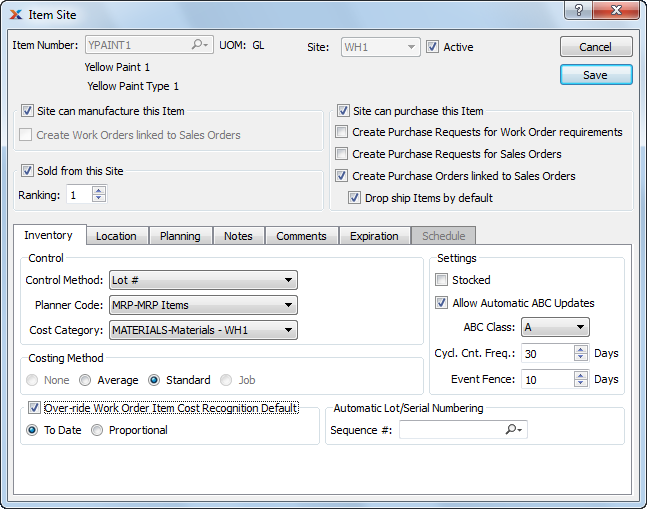
When creating a new item site, you are presented with the following options:
Enter the item number of the item you want to create an item site for.
Inventory unit of measure.
Specify site where the item site is located.
Select to indicate the item site is active. Not selecting means the item site will be considered inactive. If inactive, the item site will not appear on lists of active item sites. To re-activate an item site, simply select this option.
Select if the item can be manufactured at the specified site. Planned work orders from the material requirements planning (MRP) system can only be created for item sites having this option selected. This option is not available for purchased or outside process items if job costing is selected.
Select to create work orders whenever sales orders demand quantities from the item site. This option pertains to manufactured items. If you select this option, you are indicating that you want work orders to be generated for the item in question whenever quantities are demanded by a sales order. To ensure the Create Work Order flag is always enabled on the Sales Order Line Item screen, set the Stocked option on the Item Site screen to false. When the Stocked option is true, the Create Work Order flag will be available but turned off by default on the Sales Order Line Item screen.
Work orders created, as specified above, to meet sales order demand will be created regardless of an item's availability—and also regardless of whether material requirements planning (MRP) is being run in parallel.
Select if you want the item site to be used for purchasing the item. This option will be selected automatically (and cannot be changed) for purchased or outside process items when the job costing method is specified.
Select to create purchase requests whenever work orders demand quantities from the item site. This option pertains to purchased and outside-process items. If you select this option, you are indicating that you want purchase requests to be automatically generated for the item in question whenever quantities are demanded by work orders.
Purchase requests created to meet work order or sales order demand will be created regardless of item availability—and also regardless of whether material requirements planning (MRP) is being run in parallel.
Select to create purchase requests whenever sales orders demand quantities from the item site. This option pertains to purchased and outside-process items. If you select this option, you are indicating that you want purchase requests to be automatically generated for the item in question whenever quantities are demanded by sales orders. This option and the Create Purchase Orders linked to Sales Orders option are mutually exclusive.
Select to create purchase orders linked to sales orders. You must have at least one item source defined for the item to use this option. Linking purchase orders to sales order creates the basic foundation for drop shipment functionality. This option and the Create Purchase Requests for sales orders option are mutually exclusive. If your site is configured to use drop shipping, the following additional option will also be available:
If selected, the Drop Ship flag will always be turned on when sales order line items are created for drop ship items. Do not select this option if you want users to manually select the Drop Ship flag when entering sales orders. This option will only be visible if your site is configured to use drop shipping.
Select if item is sold from specified site. If selected, Sold from means that sales orders line items may request to ship from the site. When adding sales order line items to a sales order, a Sold from site appears as the supplying site.
Select a number using the arrows, or manually enter a value up to a maximum of 10. Value entered specifies the order in which item sites will be chosen during sales order and sales quote creation. If an item is located in more than one Sold from site, the item site with the highest ranking will be chosen first. If two item sites happen to share the same ranking, selection will be based on alphabetical order. The highest ranking an item site can have is one (1).
The following control options are required for every item site:
Select a control method for the item site from the available options:
Select if you don't care to see inventory history transactions for the item site.
Select to monitor inventory history transactions for the item site using a regular method. Regular means without lot number or serial number control.
Select to impose lot number control methods on the item site. Item sites using lot number control are subject to unique processing requirements whenever inventory is received or distributed.
Select to impose serial number control methods on the item site. Item sites using serial number control are subject to unique processing requirements whenever inventory is received or distributed.
Specify the planner code you want to assign the item site to. Assigning a planner code to an item site makes it possible to group item sites by planner code for the purposes of planning.
Specify the cost category you want to associate with the item site. This requirement helps ensure that all inventory transactions involving an item site will be properly tracked and recorded in the general ledger.
If you ever need to change the cost category for an item site having quantity on hand (QOH), the inventory value will be transferred in the ledger from the initial asset account to the new asset account.
Specify the item site costing method by selecting one of the available options:
This cost method is automatically selected for the item site if the control method is None or the item type is reference.
Cost distributions are based on an average of all costs accumulated for the item site. The QOH of item sites defined with this cost method will not be allowed to go negative.
Cost distributions are based on the standard cost posted for the item. This is the default costing method for all newly-created item sites.
Cost distributions are based on actual accumulation of costs on a work order. This cost method should be used for manufactured items which you want to handle as job items. Job items are specifically for make-to-order or service (i.e., repair) scenarios where simplified production is required. Job items cannot be maintained in inventory. Job items also have no concept of standard cost or cost variances. All costs for job items are actual. The work orders which create job items can only be created via a sales order. The costs for job item work orders are accumulated to WIP, and then transferred directly to cost of sales when the job is shipped. Production for a job item work order is posted when the linked sales order item is issued to shipping. BOM and routing items may be assigned to job items; however, they will not roll up to a standard cost for job items. Job items may be configured. This means you can add list prices to any job item characteristics. These characteristic prices are then added to the base price of sales order items when the characteristic is selected at sales order entry.
Job cost items must have a control method of regular, lot, or serial.
Select from the following settings options:
Select if the item is stocked at the specified site. This option is used in conjunction with the Create Work Orders linked to Sales Orders option on the Item Site screen. When the Stocked flag is set to false, the Create Work Order flag on the Sales Order Line Item screen will be enabled by default. Conversely, when the Stocked flag is set to true, the Create Work Order flag will be available but turned off by default on the Sales Order Line Item screen. This setting is also used to drive the constraint management system. As a result, to avoid inaccurate results when running that system, an item site must also have a reorder level defined to use this option.
Select to allow the ABC class setting for the item site to be updated whenever the ABC Class Update utility is run. Not selecting indicates the ABC class for the item site should not be updated whenever the ABC Class Update utility is run.
Specify the ABC classification for the specified item.
Cnt. Freq.: Select a number using the arrows, or manually enter a value up to a maximum of 999. A cycle count is a periodic issue of a count tag to count inventory quantity within an item site. The cycle count frequency defines the length of that period, measured in days.
To monitor the frequency of item site cycle counts, view the Last Counted column in any of the item site reports: by item, by class code, etc. The last counted date represents the date a count tag was last posted (not simply issued) for the item site.
Select a number using the arrows, or manually enter a value up to a maximum of 999. Specify the period of time, measured in days, within which relevant event notifications should be issued. If an event affecting the item site occurs within the event fence, then the system will issue a notification. Consider the case of a manufactured item whose event fence is set to five days. Assume that a work order exists for this item and that the scheduled start date for that work order is three days from the current date. If someone were to change the quantity of that work order, the event WoQtyChanged would be triggered. And because the work order start date falls within the event fence for the item site, an event notification would be issued.
The work order item cost recognition default is set globally at the system level. For more information, please see Work Order Cost Recognition Defaults. However, it is possible to override the global default by specifying one of the following options at the item site level:
The appropriate reporting selections must be made in the routing to ensure that labor and overhead costs associated with setup and run time operations are reported.
When work orders for average cost or job items are shipped, all of the WIP costs accumulated to date will be charged to cost of sales.
When work orders for average cost or job items are shipped, a value up to the proportional value of the total quantity shipped will be charged to cost of sales. For example, if three items are to be shipped on a job work order and all the material has been issued—and if only one of the three is shipped—then 1/3 of the value charged to WIP at that point will be charged to cost of sales.
If you want lot/serial numbers to be automatically generated whenever inventory is received into the item site, then select a lot/serial sequence to associate with the item site. Automatically generated lot/serial numbers may be overridden manually, if necessary. Items that require expiration or warranty information will still require that information to be entered on the Create Lot/Serial screen. For more information, please see Section 9.2.6, “Lot/Serial Sequences”.
If a user cancels, deletes, or over-writes an automatically assigned lot/serial number, the automatically incremented number will not be rolled back or reused. This is because there is no way to ensure number issuance integrity in an environment where multiple users are posting simultaneously—other than to issue new unused numbers during every transaction. The system will, however, check each number it attempts to issue. If it finds any existing matches already in the database for the given item, it will skip past them until it finds a previously unused number.
Item sites have several location control choices. To view location control choices for an item site, select the tab. The following screen will appear:
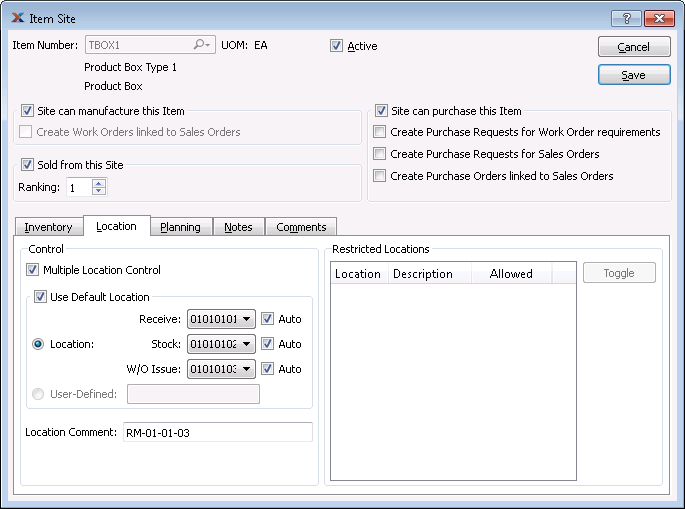
When viewing location control choices for an item site, you are presented with the following options:
Select if the specified item is to be stored in multiple locations within a single site. Items designated as multiple location control (MLC) items require special processing whenever item quantities are distributed.
Exercise caution when adjusting the multiple location control (MLC) setting for an item site. If you turn off MLC for an item site which was previously MLC, you will lose detailed inventory records for that item site. All quantity will be merged into one QOH value for the item site.
Default location: Select to designate one location within a site as the default location for the specified item. This option may be used for single location and multiple location control (MLC) items alike. You may find that inventory distributions for MLC items are greatly simplified if you designate a default location.
Specify the site location to be used as the default location for each of the following:
Used for production work order receipts, purchase order receipts, return authorization receipts and miscellaneous inventory receipts.
Used for transaction types that do not fall under the other default types (i.e., receive and W/O issue).
Used for work order material issues and backflushing.
If this automatic distribution checkbox is checked against a particular default location, the Distribute Inventory window will distribute inventory automatically without providing an opportunity to override the default. This will effectively allow the posting of inventory transactions for multi-location items without having to make any distribution decisions.
This option is not available for items that are serial or lot controlled.
This is a free-form field for describing storage areas with a site not specifically designated as site locations. A user-defined location is non-transactional, but may be used for reporting purposes.
Enter any free-form comment related to the site location. This is additional information which may be placed on a pick list or a pack list.
Select to require the use of work-in-process (WIP) locations when posting work order operations for multiple location control (MLC) finished goods. WIP locations are an optional feature which may be defined on the routing for manufactured MLC items. The feature enables you to track finished goods inventory as it moves through the manufacturing process. If your site does not combine multiple location control with operations posting, then this option should be left unchecked.
Displays restricted locations associated with the site the item site is located in.
The following buttons are unique to this screen:
Highlight a site location and then select this button to change the allowed status for the item. Any changes made on the item site master related to an item's allowed status will also be saved to the Site Location master record.
To set the item site planning parameters, select the tab. The following screen will appear:
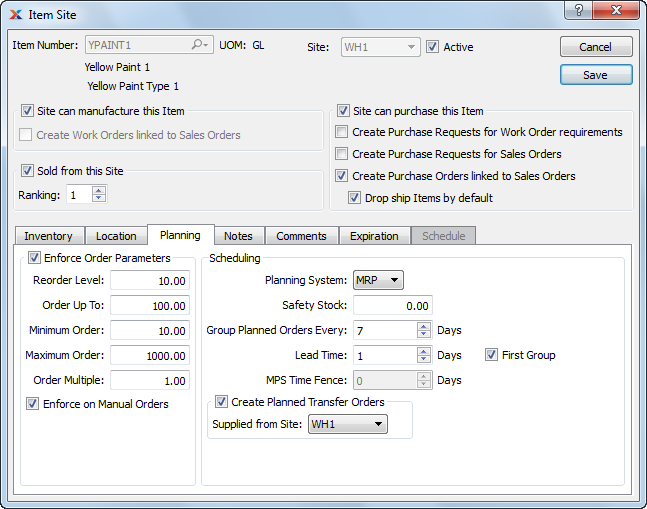
When setting the item site planning parameters, you are presented with the following options:
Select to enforce order parameters. If this option is selected, then material requirements planning (MRP) will follow the order parameters defined below when generating planned replenishment orders. Parameters you define will be saved if this option is turned ON/OFF. If you want to enforce order parameters on manual orders as well, select the on Manual Orders option.
Running material requirements planning (MRP) on your system consists entirely of running the Create Planned Replenishment Orders screens—either by item or by planner code. As MRP runs, the planned replenishment orders are generated automatically.
The reorder level specifies when a planned replenishment order should be created for an item site. If planned availability minus safety stock falls below the reorder level, then a replenishment order will be created when material requirements planning (MRP) is run. The replenishment order quantity will be equal to the quantity required to return planned availability to either the reorder level or the order up to quantity—whichever is greater.
Planned availability differs from QOH. The difference is that planned availability considers both QOH and also the time-phased demands placed on inventory by sales orders and work orders. MRP uses planned availability when calculating which item sites require planned replenishment orders.
The order up to (OUT) level indicates the level of planned availability an item site should be replenished up to when material requirements planning (MRP) is run. In cases where the reorder level for an item site exceeds the order up to level, MRP will replenish the item site up to the reorder level.
Setting the order up to level to "0" removes any restrictions on maximum order quantities. Removing quantity restrictions can be an effective strategy to help ensure that all order demands are satisfied when MRP is run. Order demands may not be met if order up to levels are set below the demand threshold.
Value entered indicates the minimum quantity that may be entered for a planned replenishment order when MRP is run. If the on Manual Orders option is selected above, manually-created work orders will recognize the minimum order value.
This is a special setting which regulates the maximum quantity for planned replenishment orders when MRP is run. The setting does not apply to manual orders, but to planned orders only. When a maximum order quantity is specified, MRP will ignore order multiples and minimum order specifications—focusing instead solely on the maximum order setting. For example, if the maximum order quantity is set to 10 and there is demand for 17, then planned orders of 10 and 7 would be generated when MRP is run.
Setting the maximum order quantity too low has been shown to slow performance when MRP is run. Unless you have special needs (i.e., crate packaging limits) which require you to set a low maximum order quantity, you should consider setting the maximum order value to "0".
Value entered indicates the quantity multiple that should be used for planned replenishment orders when MRP is run. If the on Manual Orders option is selected above, manually-created work orders will recognize the order multiple value.
Select to enforce order parameters on manually-created work orders. If this option is selected, order parameters will also be enforced whenever work orders are manually created. This option applies only to the following two parameters: Minimum Order and Order Multiple. The other order parameters listed below do not apply to manually-created work orders. For manual purchase orders, the Minimum Order and Order Multiple parameters are determined on a vendor-by-vendor basis, using Item Source masters.
Select from the available scheduling options and parameters:
Specify which of the following planning systems you want the item site to be considered by. Keep in mind that the choice of planning system is exclusive. That is, MPS will not create planned orders for MRP items when it is run. Likewise, the MRP system will not create planned orders for MPS items when it is run.
Select if you want the material requirements planning (MRP) system to create planned orders for the item when MRP is run.
Select if you want the master production scheduling (MPS) system to create planned orders for the item when MPS is run.
Select if you want MRP and MPS to ignore the item.
Specify the quantity of stock for the item you want to keep in inventory to protect against unplanned, unforeseeable trends in your order forecasts. When material requirements planning (MRP) is run, the system considers the safety stock value when determining whether to create planned replenishment orders. If planned availability minus safety stock is below the reorder level, then planned orders will be created. If not below the reorder level, then no planned orders will be created. The system's calculation effectively creates a buffer inventory (if needed) to handle unexpected fluctuations in demand. If you do not want to use the safety stock functionality, set the safety stock value to "0".
Specify the length of a period—measured in days—within which MPS or MRP planned orders will be grouped together (i.e, consolidated) to meet demand for the period. The minimum possible number of days is one. This functionality serves to limit the total number of planned orders, thereby simplifying order processing. For example, to consolidate demand for an item site into 30-day buckets, set the value to "30." When MRP is run, the system will automatically consolidate all demand falling within the 30-day horizon into a single planned purchase order or planned work order. The grouping of planned orders moves forward in time, meaning the system will create as many buckets as will fit within the cutoff date specified when MRP is run.
The initial grouping of planned orders is handled differently than subsequent buckets. The following formula specifies how the date range for the initial group is determined:
(First Group) Start Date = Current Date
(First Group) Due Date = Current Date + Lead Time
All subsequent groups are determined using the following calculations:
(Next Groups) Start Date = Current Date - Lead Time
(Next Groups) Due Date = Group Start Date
Select to tell MRP to use the item site lead time for the date range of the first grouping.
Select a number using the arrows, or manually enter a value up to a maximum of 999. Specifies the lead time for the specified item, measured in days. If the item is a manufactured item, then the lead time refers to the production lead time. If the item is a purchased item, then the lead time refers to the planning lead time. The procurement lead time for purchased items is determined on a vendor-by-vendor basis, using Item Source masters. Material requirements planning (MRP) will consider lead times when calculating planned order start dates when MRP is run.
Specify the length of the demand time fence by using the arrows or manually entering a value up to a maximum of 999. The demand time fence (also known as the demand fence) is used by the master production Scheduling (MPS) system to evaluate when forecasted demand (i.e., from production plans) should be used in place of actual demand (i.e., from sales orders)—and vice versa. Measured in days, the Demand Time Fence is the period of time extending from the current day to the number of days into the future as specified in this field. The Demand Time Fence option applies only to those items which currently appear on a released production plan. If demand for these items falls within the demand time fence period, then the forecast will be ignored. If demand falls outside the demand time fence, then the larger of actual or forecasted demand will be used. MPS responds to the demand it locates by creating firm planned orders for the required quantities.
Select if you want the item site to have planned transfer orders created for it when the material requirements planning (MRP) system is run. If selected, MRP will only create planned transfer orders for the item site. Planned purchase orders or planned work orders will not be created.
Specify which site you want planned transfer orders to be supplied from when MRP is run. The site you select must have a corresponding item site for the specified item.
To add miscellaneous notes to an item site, select the tab. The following screen will appear:
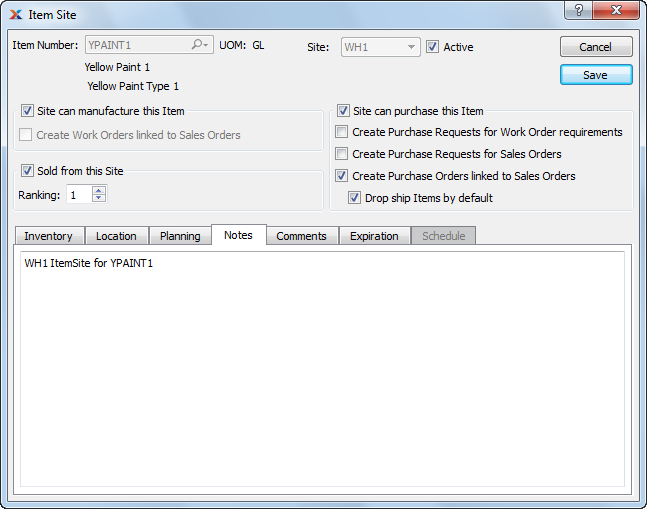
This is a scrolling text field with word-wrapping for entering free-form notes related to the item site. Notes differ from comments in that comments are time/date and user stamped.
To associate comments with an item site, select the tab. The following screen will appear:
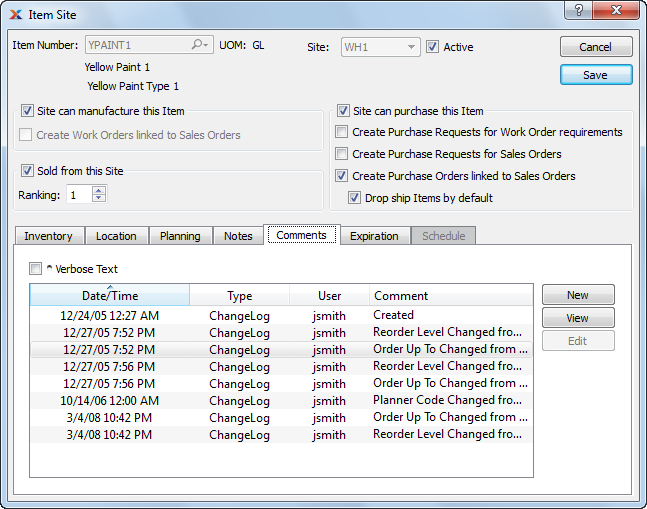
When adding or reviewing comments, you are presented with the following options:
Select to display all comments in the list in an expanded view which includes the entire text of each comment. To edit a comment, simply select the link next to the comment. That link will not be shown for changelog comments, which can't be edited. If the Verbose Text option is not selected, the comment list will display only header level information for each comment.
Display lists comments related to the record.
The following buttons are available:
Opens screen for creating a new comment.
Highlight a comment and then select this button to reach a read-only view of the Edit screen.
Enables you to edit highlighted comments—as long as the comments are not changelog comments. ChangeLog comments are system-generated and may not be edited. The Edit screen is the same as that for creating a new comment—except that when editing, the fields will contain comment information. Double-clicking on a comment will also bring you to the editing screen.
To enter a new comment, select the button. The following screen will appear:

Select a comment type from the drop-down list to classify the comment. This is a required step. Comment types may be system-defined (i.e., changelog and general) or user-defined, as described in Section 13.2.3, “Comment Types”. Once you have specified a comment type, begin typing your comment in the main text area. The text area features word-wrapping and scroll-bar support for longer comments.
The following buttons are unique to this screen:
Select to show the complete list (i.e., thread) of comments associated with the record. To hide the list, simply select the button again. The comment thread will show the most recent comment first.
If the item site is lot or serial controlled, you will have access to several product expiration options. The tab will be disabled for non-lot/serial item sites. To view or modify expiration settings for the item site, select the tab. The following screen will appear:
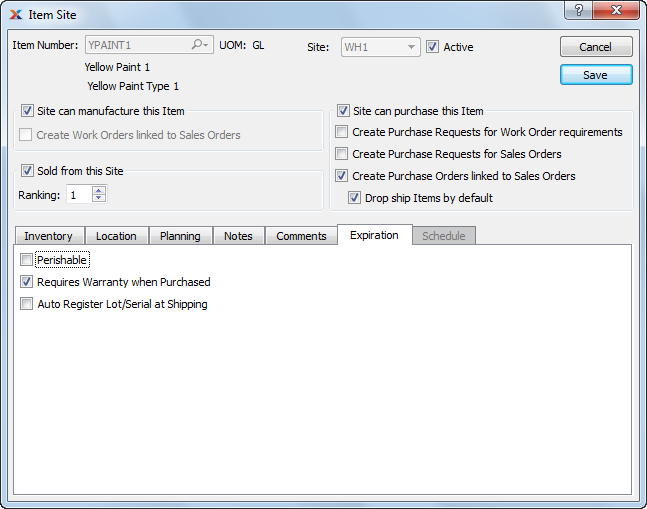
When viewing or modifying expiration settings for the item site, you are presented with the following options:
Select if the item is perishable. Materials received into a perishable item site are required to have an expiration date, thereby increasing your ability to monitor the status of the goods.
Select to require users to enter a warranty expiration date when they are receiving items into the item site. Effectively, this flag indicates the item site requires a purchased warranty.
The purchased warranty should not be confused with the sold warranty, which is defined on the Item master.
Select to automatically create a registration for lot/serial items when they are issued to shipping. You can learn more about registrations in Section 7.1, “Lot/Serial Registration”.
In order to provide for visibility of tooling for capacity planning, the system provides the ability to define capacity information at the item site level that mirrors capacity data inputs for the work center on a scheduling tab. The tab is only be enabled for tooling items, and only available on the manufacturing edition of xTuple. To view capacity information for tooling items, select the tab. The following screen will appear:
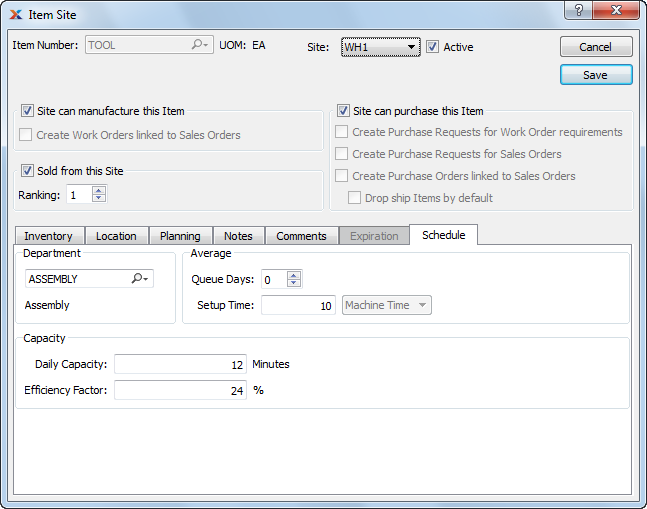
When viewing capacity information for tooling items, you are presented with the following options:
Specify the department the tooling item is associated with.
Specify the following capacity information:
Enter the daily capacity for the tooling item, measured in minutes.
Enter the efficiency factor for the tooling item, measured as a percentage.
Specify the following averages:
Enter the tooling item's average number of queue days.
Enter the setup time required for the tooling item.